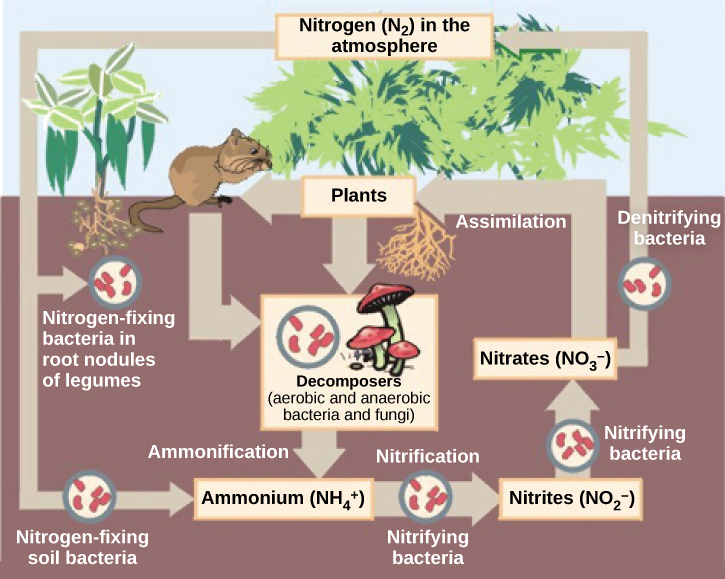Nitrogen Fixation: A Key Process for Sustainable Agriculture
Nitrogen is an essential nutrient required by plants for their growth and development. It is a critical component of amino acids, proteins, DNA, and chlorophyll. Without nitrogen, plants cannot grow well or produce fruit or seeds. However, the atmosphere contains 78% nitrogen gas (N2), which is not readily available to most plants in its gaseous form. Nitrogen fixation is the process that converts atmospheric nitrogen into a usable form that plants can absorb and use.
There are two primary ways in which nitrogen fixation occurs naturally: biological and abiotic.
Biological Nitrogen Fixation
Biological nitrogen fixation involves the conversion of atmospheric N2 into ammonia (NH3) by certain types of bacteria called diazotrophs. These bacteria live symbiotically with some plant species such as legumes (e.g., beans, peas, lentils). The rhizobia bacteria colonize the roots of these plants to form nodules where they convert N2 gas into NH3 via an enzyme called nitrogenase.
The NH3 produced by rhizobia bacteria then gets converted to ammonium ions (NH4+) that can be absorbed by plant roots to support their growth and development. The plant provides energy-rich compounds such as sugar and carbohydrates to feed the rhizobia bacteria in exchange for fixed nitrogen that boosts its productivity.
Other groups of free-living soil bacteria such as Azotobacter also fix atmospheric N2 through aerobic respiration under favorable conditions like warm temperatures and moist soils with high organic matter content.
Abiotic Nitrogen Fixation
Abiotic processes involve non-biological reactions like lightning strikes that ionize N2 molecules in the atmosphere resulting in nitrate production upon reacting with water vapor during rain events. This type of natural event contributes only about 5% of global fixed nitrogen each year but has been historically important in establishing early life on Earth.
Anthropogenic Nitrogen Fixation
Apart from natural nitrogen fixation processes, humans have developed various industrial methods to produce nitrogen fertilizers. These methods include the Haber-Bosch process, which involves high-temperature and pressure reactions between N2 gas and hydrogen gas (H2) derived from natural gas or petroleum-based sources. The resulting ammonia is then processed further into other forms of nitrogen fertilizers such as urea, ammonium nitrate, and diammonium phosphate used in agriculture globally.
The use of synthetic fertilizers has significantly increased crop yields over the past century but has also resulted in environmental problems such as eutrophication of water bodies, soil acidification, air pollution through nitrous oxide emissions that contribute to climate change.
Benefits of Biological Nitrogen Fixation
Biological nitrogen fixation offers several advantages over synthetic fertilizer use. It improves soil health by increasing organic matter content due to rhizobia bacteria’s ability to fix atmospheric N2 directly into plant tissues via nodules. This process enriches soils with bioavailable nitrogen without degrading its physical properties like texture or structure.
Legume crops grown using biological nitrogen fixation require less synthetic fertilizer input than non-legume crops since they can fix their own nitrogen needs from the atmosphere during their growth cycle. This reduces costs for farmers while improving crop productivity and quality.
Biological nitrogen fixation is an environmentally friendly approach to farming since it reduces greenhouse gas emissions associated with synthetic fertilizer production and transportation worldwide while promoting sustainable agricultural practices that benefit both farmers’ livelihoods and ecosystem services like pollination and biodiversity conservation efforts.
Challenges Facing Biological Nitrogen Fixation
Despite its benefits, biological nitrogen fixation faces some challenges in achieving widespread adoption in modern agriculture systems globally. One challenge is the lack of scientific knowledge regarding how different plant-microbe species interact within agroecosystems under varying environmental conditions like temperature or moisture levels.
Another challenge facing biological nitrogen fixation is the high cost and technical expertise required for farmers to adopt different types of inoculants or biofertilizers that contain specific strains of rhizobia bacteria. This makes it difficult for small-scale farmers in developing countries with limited resources to access these products.
Moreover, biological nitrogen fixation requires careful crop rotation management strategies since not all crops can form symbiotic relationships with rhizobia bacteria. Some crops like cereals require significant amounts of synthetic fertilizer input even when grown in rotations with legume crops due to their nutrient requirements.
Conclusion
Nitrogen fixation is a critical process in sustainable agriculture worldwide. Biological nitrogen fixation offers numerous benefits over synthetic fertilizers use such as reduced environmental impacts, improved soil health, and increased crop productivity while promoting sustainable farming practices globally. However, challenges facing its adoption require more scientific research investment and policy support from governments worldwide to promote sustainable agricultural systems that benefit both human livelihoods and ecosystem services alike.


Leave a comment